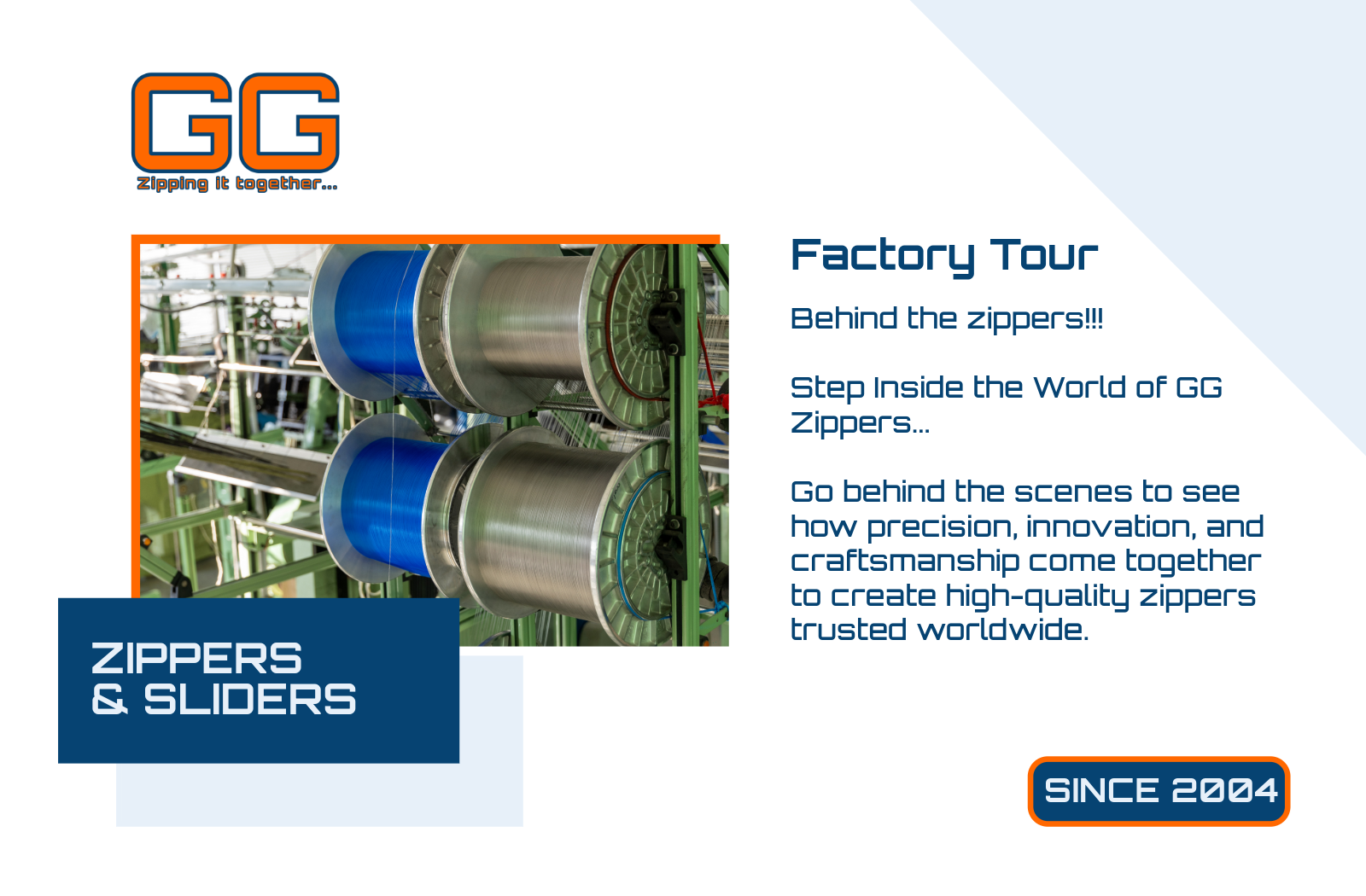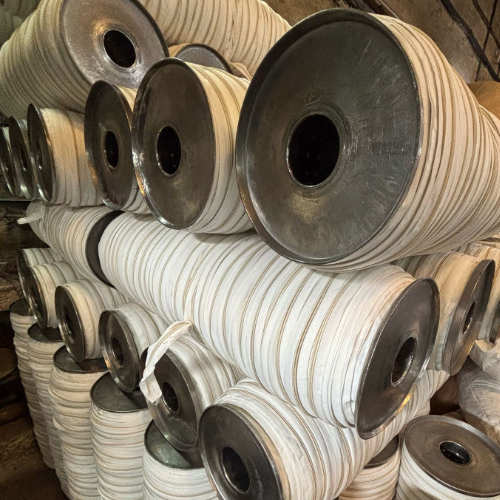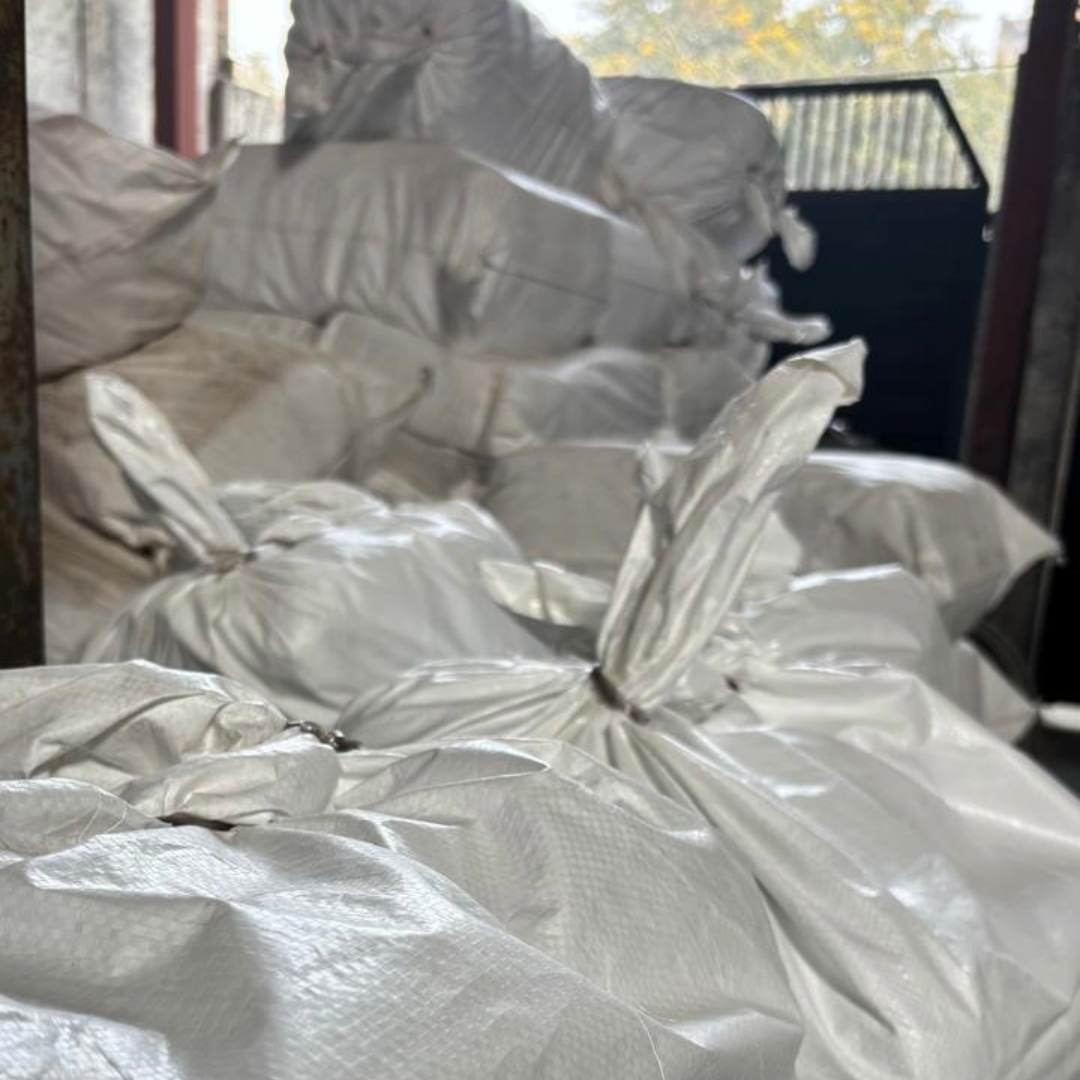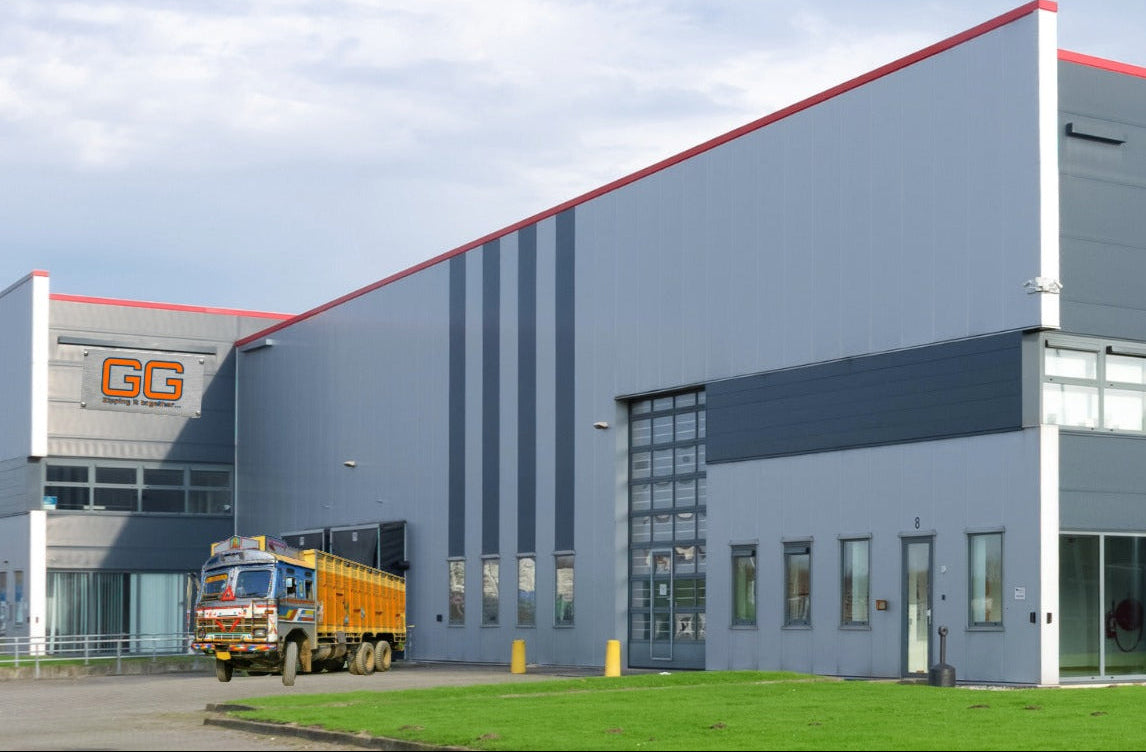
The Art Of Polyester Zipper Rolls Making !
Kindly complete the "Get In Touch" form below to book a factory tour or WhatsApp / Call us at +91-8791010316

STEP ONE - TAPE LOOMING
The Loom Section
The process begins in our Loom Section, where polyester yarns are woven into sturdy, narrow tapes using high-speed narrow fabric loom machines. These tapes form the base structure of the zipper and must meet precise width and tensile strength requirements. Quality checks are done at every stage to ensure uniformity and durability in the final product.

STEP TWO - CHORD MAKING
The Chord Section
In this section, multiple strands of polyester yarn are twisted and wound together to create a single, durable chord.
This chord provides the internal structure for the zipper coil and plays a vital role in its strength and flexibility.
Our twisting and winding machines are calibrated to maintain tight twist ratios for optimal performance.

STEP THREE - COIL FORMING
The Coiling Section
The CFC (Continuous Filament Coil) coil is formed by feeding polyester monofilament yarn into specialized coil forming machines.
The yarn is shaped into a spiral coil and interlocked around the chord. This intricate process ensures that the coil is strong, flexible, and smoothly aligned for flawless zipper operation.

STEP FOUR - SWEING YARN PREPARATION
The Twisting Section
Before stitching the zipper together, we prepare a strong polyester sewing yarn by twisting fine filaments into a durable thread.
This sewing yarn, also called stitching yarn, is engineered to hold the coil and tape securely together, even under high stress.
This section ensures the yarn has the right balance of strength and softness.

STEP FIVE - ASSEMBLY ( COIL + TAPE )
The Stitching Section
This is where the zipper starts to take its recognizable form.
Using high-precision machines, the coil is stitched onto the tape using the sewing yarn prepared earlier.
The result is a raw zipper – uncolored and uncut – ready for further customization.
Each zipper is checked for stitch strength and coil alignment to ensure smooth running.

COLOUR RECIPE DEVELOPMENT
The Matching Lab.
Between stitching and dyeing, customer-provided swatches or color samples are analyzed in our Dye Matching Lab.
Our expert team formulates the exact color recipe for the dyeing process.
This lab plays a critical role in ensuring perfect color matching and maintaining consistency across batches.

STEP SIX - WINDING FOR DYEING
The Winding Section
In this section, the raw zippers are carefully wound onto 32-inch bobbins in a uniform manner.
This allows the dye to be absorbed evenly in the next stage.
Each bobbin is labeled and matched with its respective color code to avoid any mixing or confusion during the dyeing process.

STEP SEVEN - HOT POLYESTER DYEING
The Dyeing Section
The bobbins are loaded into high-efficiency dyeing machines where they undergo hot steam-based polyester dyeing.
Using the color recipes developed earlier, the dye penetrates deep into the tape and coil, producing vibrant, long-lasting colors.
We monitor temperature, pressure, and timing closely as per the shade to maintain precision and uniformity.

STEP 8 - DEWATERING / EXTRACTING WATER
The Hydro Section
After dyeing, the zipper tapes are still saturated with dye water.
In this section, they are placed into high-speed hydro extractors that spin the bobbins to remove excess water.
This step ensures that the tapes move to the next stage with minimal moisture, speeding up the drying process and preventing water marks.

STEP 8 HEAT SETTING / PRESSING
The Pressing Section
Here, the zippers go through large heat-setting or pressing machines that dry them at controlled temperatures.
This process sets the tape and coil permanently into their final shape and texture, while also enhancing the color fastness.
Once dried and pressed, they are stored in open containers for cooling and stabilization.

STEP 10 - ROLL FORMATION
The Rolling Section
Zipper tapes are now measured and rolled into customer-specified lengths – 100 yards, 200 yards, or custom sizes.
Each roll is packed into branded LDPE polybags that protect them from dust, moisture, and damage during storage or shipping.
The rolls are neatly labeled for easy identification.

STEP 11 - GETTING READY FOR SHIPPING
The Bagging Section
The packed rolls are now organized into larger packaging units based on the order destination.
For local orders, we use PP woven bags. For international shipments, sturdy corrugated cartons are used, these also depend on the customers requirements.
This section ensures that every order is securely packaged and ready for transit.

STEP 12 - READY TO SHIP
The Dispatch Section
Once documentation and quality checks are complete, the zipper bags are moved to the dispatch zone.
Upon receiving the green signal, they are loaded into containers, trailers, or cargo vehicles, depending on the shipping method.
This final stage ensures timely and safe delivery to customers across India and the globe.
More to be added here...
Other Sections :-
1.Plastic Zipper Rolls Section,
2. Metal Zipper Rolls Section,
3. Cut Zipper Section,
4. Slider Dye Casting Section.
Want to know more about our process - Book a free factory tour and experience it first hand?
Kindly complete the "Get In Touch" form below to book a factory tour or WhatsApp / Call us at +91-8791010316
Get In Touch
State-Of-The-Art Infrastructure
We have established ourselves as a leading manufacturer and supplier of premium-quality zippers and sliders, known for their durability, superior craftsmanship, and cost-effectiveness.

Zipping It Together... SINCE 2004
PREM POLYTEX
GG is a leading brand specializing in high-quality zippers and sliders. With a strong commitment to innovation and excellence, we offer a diverse range of fastening solutions tailored to meet the evolving needs of our customers.
-

20+ Years Of Experience
-

200+ Global Clients
-

Easy Payment Terms
-

Fast And Express Deliveries

Testimonials
Read Our Informative Blogs
-

ISO 45001:2018 – Prioritizing Workplace Safety ...
Introduction Workplace safety is a fundamental concern for any manufacturing industry. Ensuring the health and well-being of employees not only protects workers but also enhances productivity and operational efficiency. ISO...
ISO 45001:2018 – Prioritizing Workplace Safety ...
Introduction Workplace safety is a fundamental concern for any manufacturing industry. Ensuring the health and well-being of employees not only protects workers but also enhances productivity and operational efficiency. ISO...
-

ISO 14001:2015 – Sustainability in Zipper Manuf...
Introduction In today's world, sustainability is no longer an option—it is a necessity. Businesses across industries are expected to adopt environmentally responsible practices to minimize their ecological footprint. ISO 14001:2015,...
ISO 14001:2015 – Sustainability in Zipper Manuf...
Introduction In today's world, sustainability is no longer an option—it is a necessity. Businesses across industries are expected to adopt environmentally responsible practices to minimize their ecological footprint. ISO 14001:2015,...
-

ISO 9001:2015 – Ensuring Quality in Every Zipper !
Introduction In the world of manufacturing, maintaining consistent quality is crucial for customer satisfaction and brand reputation. ISO 9001:2015, the international standard for Quality Management Systems (QMS), plays a vital...
ISO 9001:2015 – Ensuring Quality in Every Zipper !
Introduction In the world of manufacturing, maintaining consistent quality is crucial for customer satisfaction and brand reputation. ISO 9001:2015, the international standard for Quality Management Systems (QMS), plays a vital...
-

Why ISO Certifications Matter in Zipper Manufac...
Introduction In today’s global market, quality, safety, and sustainability are not just buzzwords—they are essential benchmarks that define a company’s credibility. Customers and businesses alike prefer suppliers who follow internationally...
Why ISO Certifications Matter in Zipper Manufac...
Introduction In today’s global market, quality, safety, and sustainability are not just buzzwords—they are essential benchmarks that define a company’s credibility. Customers and businesses alike prefer suppliers who follow internationally...
GG Zippers - zipping it together...
Frequently Asked Questions
What factors should I consider when choosing a zipper for my application?
Consider material, size, strength, weather resistance, and customization options to ensure durability and functionality.
Which type of zipper is best for outdoor and camping gear?
Waterproof and heavy-duty zippers are ideal for tents, sleeping bags, and outdoor jackets as they offer weather resistance and long-lasting durability.
Are metal zippers more durable than plastic or polyester zippers?
Metal zippers are generally stronger and more durable, making them ideal for jeans, leather goods, and boots. However, plastic and polyester zippers are lightweight and more flexible for different applications.
What type of zipper is commonly used in fashion and apparel?
Metal zippers add a premium touch to jackets and jeans, polyester zippers are widely used in everyday wear, and invisible zippers are preferred for dresses and skirts.
Which zippers are best suited for industrial and safety applications?
Fire-resistant and waterproof zippers are commonly used in industrial uniforms, military gear, and automotive applications to withstand extreme conditions.
Can zippers be customized for branding and promotional purposes?
Yes, custom zippers with unique colors, pullers, and branding options are available for corporate giveaways, promotional bags, and merchandise
Get In Touch
Factory Tour
Behind the Scenes at GG Zippers: A Factory Tour of Our Polyester Zipper Roll Production
Welcome to GG Zippers – where precision meets performance, and quality begins at the core. As one of India's trusted CFC zipper manufacturers, we’re proud to take you on a step-by-step behind-the-scenes tour of how our polyester zipper rolls are made. From the very first strand of yarn to the final packed roll ready for shipment, each stage is handled with care, expertise, and a commitment to excellence. Let’s dive into the world of zippers and explore the complete journey of a GG Zipper.
Step 1: Loom Section – Where It All Begins
The journey of a zipper starts with the loom. In this section, high-strength polyester yarns are transformed into narrow fabric tapes using our advanced narrow fabric loom machines. These tapes are the foundational material for every zipper. Our looms operate with speed and precision to ensure consistency in width, density, and strength. Each roll of tape undergoes a quality check to ensure there are no flaws in the weave, as even the slightest imperfection can impact the final product. This is where durability begins.
Step 2: Chord Section – Twisting Strength Into Shape
Next, we move to the Chord Section, where multiple polyester yarns are twisted together using specialized twisting and winding machines. This creates a single, strong chord that will soon become the inner structure of the zipper coil. The chord must be consistent in twist tension to ensure strength and flexibility. It’s a critical hidden component that provides the zipper with its lasting strength. Without a well-made chord, the coil wouldn’t hold its shape or endure heavy usage.
Step 3: Coiling Section – Forming the Coil
This is one of the most fascinating parts of the process. The coiling section is where polyester monofilament yarn is formed into a continuous filament coil (CFC). At the coil forming machines, the monofilament yarn is wrapped around the chord and shaped into a spiral coil. This coiled structure is what gives the zipper its interlocking mechanism. It’s a delicate process where uniformity and alignment are key. Every loop must be identical, every twist must be perfect. This is the beating heart of the zipper.
Step 4: Twisting Section – Preparing the Stitching Yarn
While the coil is being formed, we simultaneously prepare the stitching yarn – the thread that binds the coil to the tape. In the Twisting Section, fine polyester filaments are twisted into a strong and smooth sewing yarn. This yarn needs to be resilient yet soft enough to pass through the coil and tape without damaging them. Precision machines ensure the right number of twists per inch to give it maximum strength.
Step 5: Stitching Section – Bringing It Together
Now comes the moment of assembly. In the Stitching Section, the coil is stitched onto the woven tape using the specially prepared sewing yarn. High-speed, computerized stitching machines ensure that the stitching is tight, secure, and evenly spaced. The result is a raw zipper – not yet dyed or finished – but fully functional. At this point, the zippers are ready to take shape and color. Quality inspectors closely examine each batch to check for missed stitches, misalignment, or gaps in the coil.
Dye Matching Lab – Where Colors Come to Life
Before the zippers can be dyed, we need to ensure the colors are just right. At our in-house Dye Matching Lab, we receive fabric swatches or Pantone codes from customers and develop exact color recipes. This lab is equipped with modern tools and experienced technicians who ensure perfect color matching. This stage is critical for our fashion, bag, and garment clients who rely on us to match their brand colors exactly.
Step 6: Bobbin Winding Section – Getting Ready for Dyeing
Once the zippers are stitched and the color recipe is prepared, the raw zippers are wound onto 32-inch bobbins. The winding must be done evenly to ensure uniform dye penetration. We take great care to wind the zippers with consistent tension, avoiding overlapping or loose ends. Each bobbin is marked with a color code and batch number to maintain full traceability.
Step 7: Dyeing Section – Transforming With Color
With the bobbins prepared, we move to the Dyeing Section. Here, the bobbins are loaded into high-capacity dyeing machines that use steam and pressure to dye the polyester zippers. Our dyeing process is eco-friendly and efficient, using minimal water and chemicals. The steam dyeing process ensures vibrant, long-lasting color that doesn’t fade or bleed. Multiple quality checks are conducted at this stage to ensure color consistency across batches.
Step 8: Hydro Extraction Section – Spinning Out Excess Water
Post dyeing, the zipper tapes are still soaked. They are transferred to our Hydro Extraction Section where they are spun at high speeds to remove excess water. This step is crucial to ensure that the zippers dry faster and evenly in the next stage. The high-speed centrifugal force extracts moisture without damaging the delicate tape or coil. This stage also helps in preserving the dye's integrity and preventing blotches.
Step 9: Heat Setting Section – Drying and Locking the Shape
Once excess moisture is removed, the bobbins are moved into large heat-setting or pressing machines. These machines use precise temperatures to dry and press the zippers into their final structure. Heat setting not only dries the tape but also locks the coil and tape into their final shape, improving the zipper’s appearance and functionality. The tapes are stored in clean containers after this process to cool down before rolling.
Step 10: Rolling & Packing Section – Final Touches
At this point, the finished zippers are rolled into spools of 100 yards, 200 yards, or custom lengths as per customer requirements. Our packing staff then seals each roll into LDPE polybags bearing the GG Zippers branding. This packaging protects the zippers from moisture, dust, and handling damage during transportation and storage. Every roll is labeled with size, type, color, and order details to ensure smooth dispatch and tracking.
Step 11: Bagging Section – Packing for the Journey
Now the packed rolls are grouped and bagged according to the customer’s shipping preferences. For domestic orders, we use strong PP woven sacks. For international shipments, we use heavy-duty corrugated boxes for better protection during long transit. Our packing team ensures that each bag or box is sealed, labeled, and stacked carefully to avoid any movement or damage.
Step 12: Dispatch & Loading Section – Ready to Ship
Finally, the packed zipper rolls move to our Dispatch Section. Here, all final documentation is prepared, including invoices, packing lists, and shipping labels. Once everything is cleared and approved, the orders are loaded onto trailers, containers, or trucks depending on the destination. Our dispatch team ensures timely handover to logistics partners and keeps our clients informed at every stage.
Why This Process Matters
Each step in this journey reflects our dedication to quality, efficiency, and customer satisfaction. By investing in modern machinery, skilled workers, and rigorous quality checks, we make sure every roll of GG Zippers meets international standards. Whether you're a bag manufacturer, garment maker, or industrial supplier, you can rely on us to deliver zippers that are strong, consistent, and perfectly matched to your needs.
Visit Us – Experience the GG Zippers Difference
We invite you to visit our factory in Meerut to see this process live. For clients who can’t make it in person, we also offer virtual tours. Get in touch with our team to book a slot and see how we turn simple polyester yarn into world-class zippers.
For any inquiries or custom requirements, call/WhatsApp us at +91-8791010316.
Thank you for joining us on this factory tour. We look forward to partnering with you in your zipper journey!
Place Your Enquiry Today
We’re here to help—whether you need advice, samples, or immediate production.
📍 Manufacturing Unit: PREM POLYTEX, S-8, Delhi Road, Industrial Area, Partapur, Meerut - 250103, U.P., India
📍 Corporate Office: A-7, The Meerut Mall, Delhi Road, Meerut - 250002, U.P., India
📞 Call: +91-9193344566
✅ WhatsApp: +91-9193344566
📧 Email: sales@ggzippers.com
📩 Enquiry Form: Fill it out on our Zippers & Sliders Enquiry Page
🏭 Visit Us: Book a factory tour - Location
Explore our polyester zipper rolls collection and experience the GG Zippers difference in quality, flexibility, and performance! Contact us today for bulk orders or custom inquiries.













